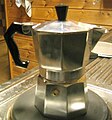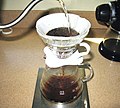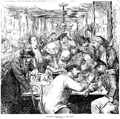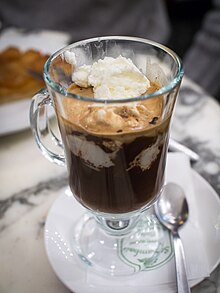The Coffee Portal
Coffee | Drinks | Coffeehouses | Companies | Culture | Preparation | Production
Introduction

Coffee is a beverage brewed from roasted coffee beans. Darkly colored, bitter, and slightly acidic, coffee has a stimulating effect on humans, primarily due to its caffeine content. It has the highest sales in the world market for hot drinks.
The seeds of the Coffea plant's fruits are separated to produce unroasted green coffee beans. The beans are roasted and then ground into fine particles typically steeped in hot water before being filtered out, producing a cup of coffee. It is usually served hot, although chilled or iced coffee is common. Coffee can be prepared and presented in a variety of ways (e.g., espresso, French press, caffè latte, or already-brewed canned coffee). Sugar, sugar substitutes, milk, and cream are often added to mask the bitter taste or enhance the flavor.
Though coffee is now a global commodity, it has a long history tied closely to food traditions around the Red Sea. The earliest credible evidence of coffee drinking as the modern beverage appears in modern-day Yemen in southern Arabia in the middle of the 15th century in Sufi shrines, where coffee seeds were first roasted and brewed in a manner similar to how it is now prepared for drinking. The coffee beans were procured by the Yemenis from the Ethiopian Highlands via coastal Somali intermediaries, and cultivated in Yemen. By the 16th century, the drink had reached the rest of the Middle East and North Africa, later spreading to Europe. ( Full article...)
Selected article -
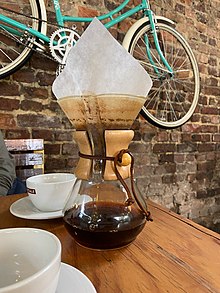
Coffee production in Colombia has a reputation for producing mild, well-balanced coffee beans. Colombia's average annual coffee production of 11.5 million bags is the third total highest in the world, after Brazil and Vietnam, though highest in terms of the arabica bean. The beans are exported to United States, Germany, France, Japan, and Italy. Most coffee is grown in the Colombian coffee growing axis region, while other regions focus on quality instead of volumes, such as Sierra Nevada de Santa Marta. In 2007, the European Union granted Colombian coffee a protected designation of origin status. In 2011, UNESCO declared the "Coffee Cultural Landscape" of Colombia, a World Heritage site.
The coffee plant had spread to Colombia by 1790. The oldest written testimony of the presence of coffee in Colombia is attributed to a Jesuit priest, José Gumilla. In his book The Orinoco Illustrated (1730), he registered the presence of coffee in the mission of Saint Teresa of Tabajé, near where the Meta river empties into the Orinoco. Further testimony comes from the archbishop-viceroy Caballero y Gongora (1787) who registered the presence of the crop in the north east of the country near Giron (Santander) and Muzo (Boyaca) in a report that he provided to the Spanish authorities. ( Full article...)General images -
More did you know? -
Selected drink -
Selected image -
Did you know (auto-generated)

- ... that actor Tatsunari Kimura ate pancakes and drank coffee while talking for eight hours during the filming of the television drama Old-Fashioned Cupcake?
- ... that Bob Dylan poked Emmylou Harris when he wanted her to start singing during the recording of " One More Cup of Coffee (Valley Below)"?
- ... that Arab Coffeehouse depicts Henri Matisse's visit to Tangier, where he saw its locals gaze for hours into fishbowls?
- ... that in a copyright infringement case over a coffee-table history of the Grateful Dead, the Second Circuit held that a reuser can still claim fair use despite negotiating with the rights holder?
- ... that Kenyan coffee farmer "Pinkie" Jackson amassed Africa's largest collection of native butterflies?
- ... that Steem peanut butter contained as much caffeine per serving as two cups of coffee?
- ... that the city council of Bandung in the Dutch East Indies initially met at the site of a former coffee-packing factory?
- ... that the short story collection Drinking Coffee Elsewhere was chosen by John Updike as a selection for the Today Show book club on NBC?
Topics
Categories
Related portals
Related WikiProjects
- WikiProject Agriculture
- WikiProject Beer
- WikiProject Food and Drink
- WikiProject Spirits (semi-active)
- Wikiproject Wine (semi-active)
- WikiProject Bartending (Inactive)
- WikiProject Breakfast (inactive)
- Wikiproject Bacon (inactive)
Associated Wikimedia
The following Wikimedia Foundation sister projects provide more on this subject:
-
Commons
Free media repository -
Wikibooks
Free textbooks and manuals -
Wikidata
Free knowledge base -
Wikinews
Free-content news -
Wikiquote
Collection of quotations -
Wikisource
Free-content library -
Wikispecies
Directory of species -
Wikiversity
Free learning tools -
Wiktionary
Dictionary and thesaurus
Web resources

- World Coffee Research – a 501 (c)(5) nonprofit program of the international coffee industry. (Wikipedia article: World Coffee Research)
- Coffee Research Foundation – based in Kenya, and founded in 1908
- Central Coffee Research Institute – based in Chickmagalur District, India, and founded in 1915



























